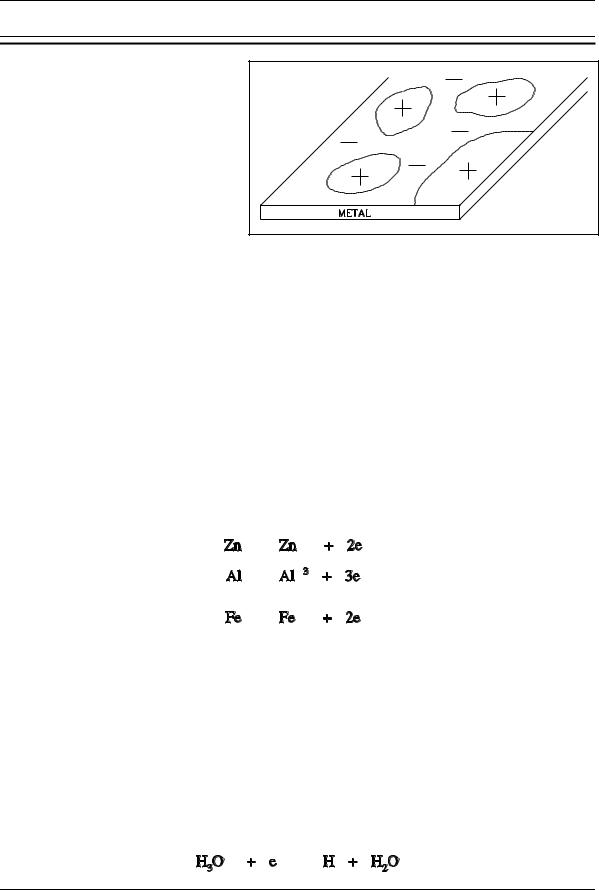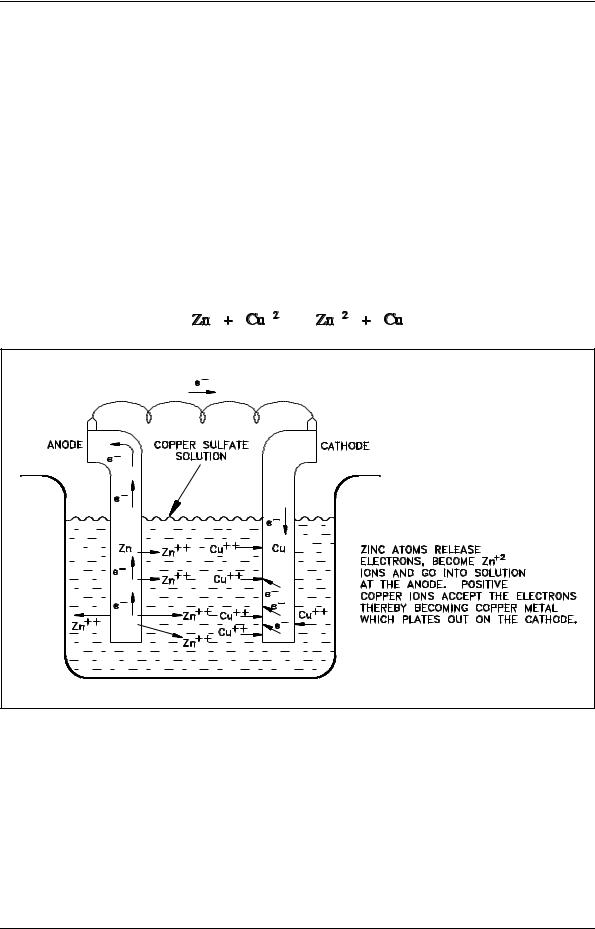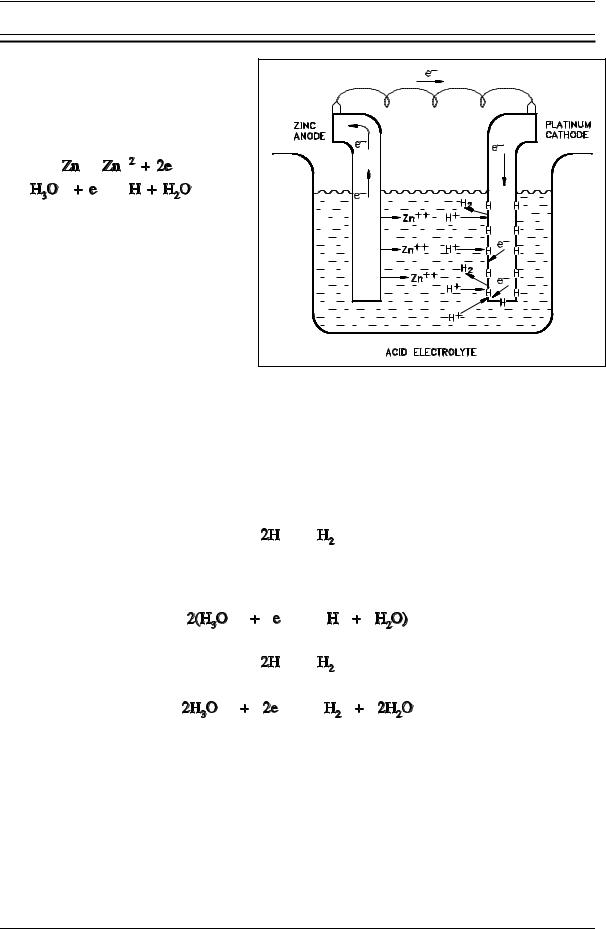
- •ABSTRACT
- •FOREWORD
- •OVERVIEW
- •TABLE OF CONTENTS
- •LIST OF FIGURES
- •LIST OF TABLES
- •REFERENCES
- •OBJECTIVES
- •CHARACTERISTICS OF ATOMS
- •Characteristics of Matter
- •The Atom Structure
- •Chemical Elements
- •Molecules
- •Avogadro's Number
- •The Mole
- •Mole of Molecules
- •Summary
- •THE PERIODIC TABLE
- •Periodic Table
- •Classes of the Periodic Table
- •Group Characteristics
- •Atomic Structure of Electrons
- •Summary
- •CHEMICAL BONDING
- •Chemical Bonding
- •Ionic Bonds
- •Covalent Bonds
- •Metallic Bonds
- •Van der Waals Forces
- •Organic Chemistry
- •Alkanes
- •Alkenes
- •Alkynes
- •Aromatics
- •Alcohols
- •Aldehydes
- •Basic Chemical Laws
- •Forming Chemical Compounds
- •Combining Elements
- •Summary
- •CHEMICAL EQUATIONS
- •Le Chatelier's Principle
- •Density
- •Molarity
- •Normality
- •Parts per Million
- •Chemical Equations
- •Balancing Chemical Equations
- •Summary
- •ACIDS, BASES, SALTS, AND pH
- •Acids
- •Bases
- •Salts
- •Dissociation Constant
- •Summary
- •Introduction
- •Isotopic Separation
- •Separation Factor
- •Stage Separation
- •Barrier Measurements
- •Cascade Theory
- •Circuit Balances
- •CONVERTERS
- •Converters
- •Converter Construction
- •The Gas Cooler
- •Barrier Tubing
- •Process Gas Flow
- •Diffusion
- •TABLE OF CONTENTS
- •LIST OF FIGURES
- •LIST OF TABLES
- •REFERENCES
- •OBJECTIVES
- •CORROSION THEORY
- •Corrosion
- •Electrochemical Cells
- •Oxidation-Reduction Reactions
- •Passivity and Polarization of Metal
- •Summary
- •GENERAL CORROSION
- •Conditions Contributing to General Corrosion
- •Corrosion of Iron
- •Factors Affecting General Corrosion Rate
- •Prevention Chemistry Control
- •Corrosion of Aluminum
- •Summary
- •CRUD AND GALVANIC CORROSION
- •Crud
- •Galvanic Corrosion
- •Prevention of Galvanic Corrosion
- •Summary
- •SPECIALIZED CORROSION
- •Pitting and Crevice Corrosion
- •Stress Corrosion Cracking
- •Summary

Corrosion |
|
DOE-HDBK-1015/1-93 |
CORROSION THEORY |
Consider iron in water again. If the |
|
||
surface of the iron and the water |
|
||
solution were uniform, iron would go |
|
||
into solution as Fe++ ions until the |
|
||
difference in potential between the |
|
||
positively-charged solution and the |
|
||
negatively-charged metal stopped the |
|
||
iron ions from leaving the surface. In |
|
||
practice, though, |
impurities |
and |
|
imperfections (for |
example, |
oxide |
|
coatings) lead to preferential removal of metal from certain parts of the
surface, and potential differences arise as in the two metal system. The corrosion cells, changing as surface and solution differences change, cause general overall corrosion. If the cells do not shift, pitting results.
Oxidation-Reduction Reactions
The corrosion of a metal (that is, the chemical transformation that is recognized as destructive to the metal) is the oxidation step of the overall oxidation-reduction process. Oxidation is the process of losing electrons; reduction is the process of gaining electrons. The metal atoms release electrons (are oxidized) and become positive ions. The site at which this occurs is known as the anode. Typical oxidation half-reactions include the following.


(2-1)
(2-2)
(2-3)
The cations (positive ions) may then go into solution, or they may combine with any available anions (negative ions) or water to form ionic compounds. The exact fate of the cations is important to subsequent processes, but the primary effect is that atoms leave the metallic state, and the metal deteriorates.
An oxidation process cannot take place without a simultaneous reduction (gain of electrons) process. The nature of the reduction step in corrosion sometimes varies with the metal and the environment to which it is exposed. For most metals in an aqueous environment, the important reduction half-reaction is the reduction of hydronium ions (a hydronium ion is simply a hydrogen ion attached to a water molecule).
|
|
(2-4) |
|
|
|
Rev. 0 |
Page 5 |
CH-02 |

CORROSION THEORY |
DOE-HDBK-1015/1-93 |
Corrosion |
|
|
|
Small concentration variations within a solution in contact with the metal may also affect the rate and nature of corrosion reactions. Therefore, it is often impossible to predict the exact nature of corrosion reactions. It is generally found, however, that for most metals exposed to an aqueous environment the half-reactions involved in corrosion are the reduction reaction of Equation (2-4) and an oxidation half-reaction of the type shown in Equations (2-1) through (2-3).
General corrosion is the process whereby the surface of a metal undergoes a slow, relatively uniform; removal of material. This occurs on the surface of a single metal rather than dissimilar metals. In general corrosion, a nearly infinite number of micro-cells are established on the metal surface. Oxidation occurs at anodic areas and reduction at cathodic areas. The micro-cells are uniformly distributed over the metallic surface, and as the reaction proceeds the cells may migrate, or disappear and re-form. That is, any particular micro-region may be alternately anodic and cathodic. The result is a uniform attack on the metal surface.
Under some conditions, relatively large regions become anodic or cathodic. Such regions have less tendency to migrate and may remain operative for long periods of time. In this case, there will be severe attack of the metal at the anodic (oxidation) region. The result may be a visible pit in the metal surface.
Iron and steel are resistant to rapid corrosion in water despite the tendency of iron to oxidize as indicated by its standard electrode potential listed in Table 1. The reasons for this resistance are the passivating effect of the oxide film and cathodic polarization due to atomic hydrogen that absorbs on the oxide surface, both of which are explained in the next section.
Passivity and Polarization of Metal
Metals that normally fall victim to corrosion will sometimes exhibit a passivity to corrosion. Passivity is the characteristic of a metal exhibited when that metal does not become active in the corrosion reaction. Passivity is caused by the buildup of a stable, tenacious layer of metal oxide on the surface of the metal. This oxide layer is formed by corrosion on a clean metal surface, where the corrosion products are insoluble in the particular environment to which the metal is exposed. Once the layer, or film, is formed, it acts as a barrier separating the metal surface from the environment. For further corrosion to occur, the reactants must diffuse through the oxide film. Such diffusion is very slow or nonexistent, thus corrosion either decreases markedly or stops.
Metals such as zirconium, chromium, aluminum, and the stainless steels form thin, tenacious oxide films when exposed to the atmosphere or to pure water at room temperature. In some cases, the film is extremely thin and may be invisible to the unaided eye, but it is still very effective in giving these metals a marked passivity.
If there is a net conversion of reactants to products in a system, the system will be chemically unstable, and the reaction will continue until a stable state is attained. This stable state is known as equilibrium.
CH-02 |
Page 6 |
Rev. 0 |

Corrosion |
DOE-HDBK-1015/1-93 |
CORROSION THEORY |
|
|
|
An active electrochemical cell (oxidation-reduction reaction) is an unstable chemical system. The potential associated with a galvanic cell, for example, steadily decreases as current flows and the oxidation-reduction reaction proceeds. Eventually, the potential falls to zero, the cell no longer supplies electrical energy, and no further net reaction takes place. At this point the system is at equilibrium. In electrochemical cells, the decrease in cell potential caused by the operation of the cell (current flow) is called polarization.
This change in cell potential can be determined. Consider the zinc-copper galvanic cell shown in Figure 3. As the reaction takes place, Zn+2 ions (produced by the oxidation of zinc metal) pass into solution. The Cu+2 ions in solution are reduced as the copper metal plates out. Thus, the concentration of Zn+2 in solution increases and the concentration of Cu+2 decreases according to the following overall reaction.
|
|
(2-5) |
|
|
Figure 3 A Galvanic Cell
As Zn+2 increases and Cu+2 decreases, the electrical potential decreases. This decrease in cell potential, which results from changes in concentrations, is one form of polarization called concentration polarization.
Rev. 0 |
Page 7 |
CH-02 |

CORROSION THEORY |
DOE-HDBK-1015/1-93 |
Corrosion |
|
Now consider a galvanic cell with zinc |
|
||
and platinum electrodes, such as that |
|
||
shown in Figure 4. The half-reactions |
|
||
in the cell are as follows. |
|
|
|
|
|
|
|
|
|
|
|
|
|
(2-4) |
|
|
|
|
|
Again, as the cell operates, the cell |
|
||
potential drops. The decrease is |
|
||
partially due to the increase in Zn+2 |
|
||
concentration and the decrease in H O+ |
|
||
|
|
3 |
|
concentration, but another type of |
|
||
polarization also occurs in this cell. |
|
||
This second type is associated with the |
|
||
reduction half-reaction. |
|
|
|
The hydrogen atoms formed by the |
Figure 4 A Galvanic Cell Showing Absorbed Hydrogen |
|
Atoms on a Cathode |
||
reaction of Equation (2-4) absorb on |
||
|
||
the surface of the metal and remain |
|
there until removed by one of two processes: combination of two hydrogen atoms to form molecular hydrogen, which is then released as a gas or reaction with dissolved oxygen to form water. In the absence of oxygen (deaerated solutions), the first process applies.
|
(2-6) |
Combining Equation (2-6) with Equation (2-4), the net reduction half-reaction is obtained.
|
|
|
|
|
(2-6) |
|
|
(2-7) |
|
|
|
Until the absorbed hydrogen atoms are removed from the metal surface, they effectively block the sites at which the reaction of Equation (2-4) can occur. At low temperatures the reaction of Equation (2-6) is slow relative to the reaction of Equation (2-4) because, although the reaction is energetically favored, the combination of two hydrogen atoms requires a large activation energy. Equation (2-6) shows the rate-controlling step of the net reduction half-reaction. Because the oxidation half-reaction can occur no faster than the reduction half-reaction, the rate of the overall oxidation-reduction reaction is controlled by the reaction of Equation (2-6).
CH-02 |
Page 8 |
Rev. 0 |
